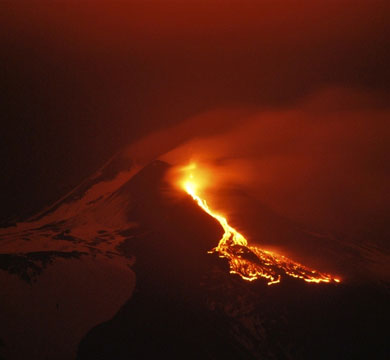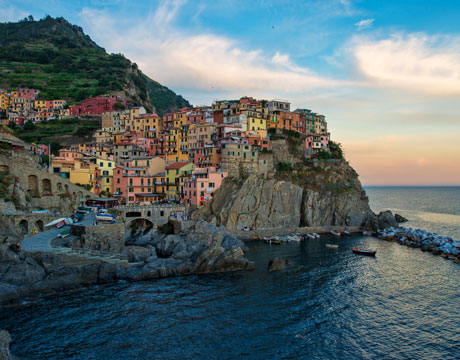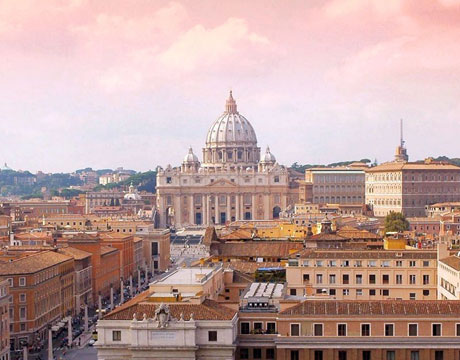Italy
Country statistics

Land area: 113,521 sq miles (294,019 sq km)
Total area: 116,306 sq miles (301,230 sq km)
Population (2010 est.): 58,090,681 (growth rate: -0.07%); birth rate: 8.0/1000; infant mortality rate: 5.4/1000; life expectancy: 80.3; density per sq km: 197
Capital City: Rome
Monetary unit: Euro (formerly lira)
Languages: Italian (official); German-, French-, and Slovene-speaking minorities
Ethnicity/race: Italian (includes small clusters of German-, French-, and Slovene-Italians in the North and Albanian- and Greek-Italians in the south)
Religions: Roman Catholic (predominant), Protestant, Jewish, Islamic
Country introduction

Italy is located in Southern Europe, and borders to the north with France, Switzerland, Austria, and Slovenia along the Alps. To the south, it predominantly consists of a large peninsula (the Italian peninsula) that extends into the Mediterranean Sea. Sicily and Sardinia are the two major islands of Italy.
The Apennine mountains form the backbone of this peninsula, leading north-west to where they join the Alps, the mountain range that then forms an arc enclosing Italy from the north. Here is also found a large alluvial plain, the Po-Venetian plain, drained by the Po River, which is Italy's biggest river, and its many tributaries flowing down from the Alps, Apennines and Dolomites. Other well-known rivers include the Tiber, Adige and Arno.
Its highest point is Mont Blanc (Monte Bianco) at 4,810 m (15,780 ft), but Italy is more associated with two famous volcanoes: the currently dormant Vesuvius near Naples and the very active Etna on Sicily.
The culture

Unparalleled in its diversity, Italy offers delights ranging from fine wines and exceptional cuisine to high art and great historical sites. The peaceful Puglia region in Southern Italy is renown for its stunning whitewashed coastal homesteads, serene hills cloaked in olive groves and vineyards, and medieval villages connected by narrow, winding streets. Inhabitants in keeping with their old traditions, distinct dialect and proud cultural heritage is well exemplified in Cinque Terre, a marvelous tourist destination featuring five seaside villages at the foot of terraced hills that fall steeply towards the sea.
As in many countries, dancing is an important component of Italian culture. Once such dance, the Tarantella, originated in the Middle Ages, and is said to be probably the most recognized song of all the Italian folklore music. It literally means "tarantula" and dancers rotate clockwise in a large circle. When the music in the set changes, and it becomes faster, the dancers quickly change the direction to counterclockwise.
Football (known as soccer in the United States) is a passion in Italy. All major Italian cities have large stadiums, but Milan's San Siro is among the most well-known. The huge 80,000-seater stadium is shared by both the Inter Milan and AC Milan teams.
Italian fashion, is also world-renowned. Gucci, Valentino, Ungaro, Versace and Armani are just a few of the couture heavyweights whose inspirations fill boutiques from Milan to Rome.
Attractions & landmarks

The Vatican City in Rome is the spiritual center of the worldwide Catholic Church and a pilgrimage destination for millions each year. Its museums display some of the world's most famous art, including Michelangelo's Sistine Chapel. In Venice, north-east of Italy, the Basilica of St. Marks looks out onto one of the most famous views in Italy. The building has played a vital role in city life since its construction almost 1,000 years ago. In addition to all of the spectacular churches there is a Byzantine church in Ravenna, St. Mark's Square in Venice, the leaning tower of Pisa, and 'David' in Florence.
Italy is famous as the home of the Roman Empire and many of the country's historical landmarks date from that time. In Rome, the Colosseum has survived almost 2,000 years of invasions, earthquakes and wars and is probably the city's most famous sight. Nearby, the sections of the buildings that made up ancient Rome's downtown are preserved, including the Rostra, where famous generals and politicians gave speeches and the Arch of Septimus Severus, built to commemorate military victories. Ancient Roman aqueducts can also be seen all over Italy and there are some famous marble quarries too.
Italy has several well-known natural landmarks, of which the two volcanoes, Etna and Vesuvius are probably the most famous. Located in North-east Sicily, Etna is the largest active volcano in Europe and has been continually active since Roman times. Visitors can climb to the top to see the crater and flows of lava. Another climbable volcano is Vesuvius, which stands overlooking the homes of two million people in and around the city of Naples. Although it has been quiet since the last major eruption in 1944, Vesuvius remains active and the high number of people nearby make it potentially dangerous.